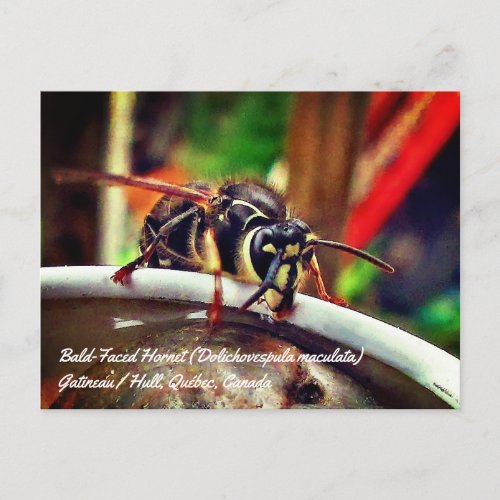Bald Faced Hornet (Dolichovespula maculata) Wasp Postcard



This bald-faced hornet having a drink at my wasp feeder. It's the end of July, and in the wasp world, female worker or queen larvae are full grown, and the males or drones are starting to emerge from their paper cells, where they've spent their larval stages. This awesome insect is actually a yellowjacket wasp, a paper wasp of the family Vespidae, and not a true hornet, which belongs to the family Vespa and also related to yellowjackets. Her markings are very pale yellow or white, with three white rings on the lower part of her abdomen. These animals have five eyes - one large compound eye on either side of the face, and three eyes on top of the head. You can see them in this picture. The triangle of eyes on her head are not developed for good vision. They are sensitive to light and shadow, and also orientation or balance. Flying insects have the three eyes on top, but ground-level insects like ants have only two. The top eyes are especially handy to detect potential attacks from above. When I photograph wasps I find they're very sensitive to the camera directly above them, and they often take off, so I have to kind of sneak the shot in. Like wasps and true hornets, this pretty lady can carry a wicked sting and sting multiple times. However, they usually do not sting, unless in defence of their nest, and if they feel they are under attack on a community or personal level, for example if someone swats at them, sits on them or takes a bite out of something upon which the insect has landed. If she thinks you're trying to eat her, she will sting, and if her nest is being destroyed, she and all her sisters will mount a furious defence. <br /> <br /> Baldfaced Hornet Facts and Trivia: The Queen is fertilized by one or two males in autumn during a swarming dance outdoors. New queens are the only members of their species to survive the winter. Workers and drones die as food sources become scarce and weather grows cold. Queens face a lot of challenges while hibernating, including spider attacks and false spring, a period of warmer weather that wakes her up, and she emerges from hibernation too early. Only a small percentage of queens make it through the winter. She finds an appropriate nesting site and starts her nest by chewing wood and woody plant fibers. Mixed in with her saliva, it creates a fine paper mache which she then molds into individual cells, using her front legs and her feelers or antennae as hands to and she deposits an egg in each one. These will hatch into the larvae or grubs of worker wasps, who will also help in the nest building, while the Queen lays more eggs. The nest is papery grey and roundish or oblong. A colony of baldfaced hornets can grow to 400 - 700 worker individuals, and the nest itself can be almost two feet long. At this time of year, the larvae have turned into adults and wasps and hornets are looking for something sweet to drink. The bald-faced hornet, like others of the family Vespidae, catches insects in the early part of the year and can be extremely beneficial in gardens to get rid of pests. She doesn't eat her catch, as adults cannot digest meat, but cuts it up, discards the inedible bits, and makes it into a neat little package which she feeds to the larvae in the nest. The larvae exude a clear sweet liquid, like flower nectar, which the adults drink. But when all the larvae have pupated and become adults, the source of sweet food is gone. That's when wasps and hornets go looking for nourishment, and often frequent barbecues and patios. A percentage of them are males who cannot sting, and the females are generally more interested in eating than stinging - she might fly around you to check you out, or crawl into a canned drink (I was stung in the mouth a couple of times because I forgot to take basic precautions, such as putting the canned drink in a glass where I could see it, and checking food before taking a bite. If you're stung there is swelling and intense pain for a day or so, up to a few days if it's a hornet sting. People who are allergic to wasp stings, or who get multiple stings, should see a doctor). Many people also have a primal fear of certain insects and arachnids like wasps, spiders and hornets, but these are fascinating and intelligent creatures who are often misunderstood. This original bald-faced hornet nature photo is by M Sylvia Chaume, Canada. Happy Blessings!


